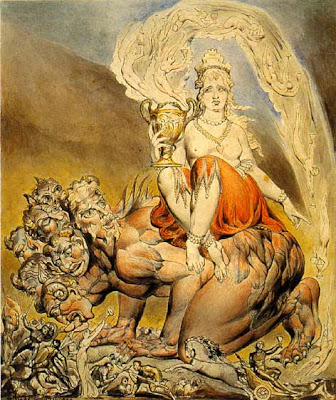Austin Osman Spare, Protection Against Evil People, 1955.
For many, the most original magician
after Crowley to formulate a unique system, of sex, ritual magic, and artistic
creations was Austin Osman Spare. The son of a London policeman, Spare
demonstrated at a young age a talent for art, which led him to briefly attend
art school. Spare’s artistic endeavour appealed to many attached to London’s
avant-garde scene, and he also attracted the attention of Aleister Crowley who
initiated into his occult order Argentium Astrum, or otherwise known as the A∴A∴. However,
Spare at the age of twenty with his most notorious work, The Book of Pleasure, would take fundamental tenet of Thelema and
the Nietzschean idea of trans-human valuation further, whilst using ritualised
sex and art to tap into the inner depths of the subconscious mind as a source
of magical power.[1]
At the core of
Spare’s magical cosmology is ‘Kia’, which is an inconceivable primal energy
that is the source of all manifestation, and in Spare’s words, “Absolute
Consciousness (Kia, the Self) like Infinite Space (Nuit) is without a boundary;
it is the plenum-void, formless and unlocatable; to all intents and purposes –
nothing at all, except that it is the sole reality.”[2]
The vehicle of this primal energy is called ‘Zos’, which refers to the human
mind and body, and the human self reflecting the Kia is also by nature
unbounded and blissful, demanding complete freedom from all laws. Therefore,
“Ecstasy in satisfaction is the great purpose. Freedom from the necessity of
law, realisation by the very wish, is the ultimate goal.”[3]
Following from this Spare declared,
In pleasure Heaven shall break
every law before this Earth shall pass away… He who is lawless is free… Without
hypocrisy or fear ye could do as ye wish. Whosoever, therefore shall break the
precept or live its transgression shall have relativity of Heaven. For unless
your righteousness exist not, ye shall not pleasure freely and creatively.[4]
More explicitly than both Randolph and
Crowley, Spare identified sex and its pleasures with the deepest nature of the
Self through which the ‘I’ becomes infinity through the only true sense to
exist, the sexual, and the only one desire, to procreate.
The most infamous of Spare’s magical
methods to achieve such as state of transgression and finally tap into the
ultimate source of magical power, consisted of the use magical sigils, abstract
ideograms made up of letter combinations expressing a particular magical
desire, and which would also act as the focus of the magicians meditation. In
order though for the magician to bring this sigilised magical desire into
reality the magician must enter an altered state of consciousness through a
gnostic trance or ecstasy. Spare’s ultimate mean to achieving this was through
sheer exhaustion, “that is, by so exhausting and emptying the mind that it is
open to forces of the subconscious, which can then manifest the idea or desire
represented in the magical sigil.”[5]
This state of altered consciousness, according to Spare, could culminate
through various ways, but the most powerful means was through the powerful
momentum of the orgasm when a state of ecstasy prevails and the ego and Kia are
in unison in a receptive state of openness and emptiness. In Spare’s word, “At
this moment, which is the moment of generation of the Great Wish, inspiration
flows form the source of sex, from the Primordial Goddess who exists at the
heart of Matter.”[6]
Spare also described the saturnalian use of,
The sense of smell, hearing and
sight seduced by incense, mantric incantation and ritual, while taste and touch
are made more sensitive by the stimuli of wine and… sexual acts. After total
sexual satiation… an affectivity becomes an exteriorized hallucination of the
pre-determined wish which is magical in its reality.[7]
Despite this liberating ecstasy being
the path to tapping into the magical source of the primal essence of being,
this final state of ‘exhaustion which Spare referred to also had a mystical
quality to it where the limits of thought are exhausted resulting in an
annihilation of all conceptual categories in a non-dualistic fashion. This
mystical current in the sexual magic of Spare is clearly expressed when,
Desire is the conception I and
induces Thou. There is neither thou nor I nor a third person – loosing this
consciousness by unity of I and Self; there would be no limit to consciousness
in sexuality. Isolation in ecstasy, the final inducement, is enough.[8]
[1] According to Kenneth Grant in
his introduction to Austin Osman Spare’s The
Book of Pleasure (Self-Love: The Psychology of Ecstasy, 1975, Sigmund Freud
allegedly described Spare’s work as “one of the most significant revelations of
subconscious mechanism that had appeared in modern times.”
[2] Kenneth Grant, The Magical Revival, 1973, 205.
[3] Austin Osman Spare The Book of Pleasure. The Hermetic
Library, www.hermetic.com/spare/pleasure.html.
[4] Austin Osman Spare The Anathema of Zos: A Sermon to the
Hypocrites, 1976, 13.
[5] Hugh B. Urban, Magia Sexualis: Sex, Magic, and Liberation
in Modern Western Esotericism, 2006, 231.
[6] Quoted in Nevill Drury, The History of Magic in the Modern Age, 2000, 123-124.
[7] Quoted in Kenneth Grant, The Magical Revival, 1973, 197.
[8] Quoted in Kenneth Grant, The Magical Revival, 1973, 201.






